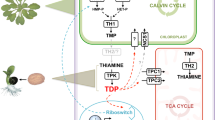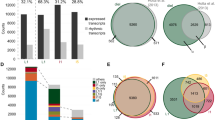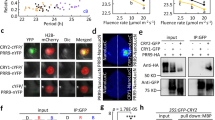Abstract
Circadian clocks provide a competitive advantage in an environment that is heavily influenced by the rotation of the Earth1,2, by driving daily rhythms in behaviour, physiology and metabolism in bacteria, fungi, plants and animals3,4. Circadian clocks comprise transcription–translation feedback loops, which are entrained by environmental signals such as light and temperature to adjust the phase of rhythms to match the local environment3. The production of sugars by photosynthesis is a key metabolic output of the circadian clock in plants2,5. Here we show that these rhythmic, endogenous sugar signals can entrain circadian rhythms in Arabidopsis thaliana by regulating the gene expression of circadian clock components early in the photoperiod, thus defining a ‘metabolic dawn’. By inhibiting photosynthesis, we demonstrate that endogenous oscillations in sugar levels provide metabolic feedback to the circadian oscillator through the morning-expressed gene PSEUDO-RESPONSE REGULATOR 7 (PRR7), and we identify that prr7 mutants are insensitive to the effects of sucrose on the circadian period. Thus, photosynthesis has a marked effect on the entrainment and maintenance of robust circadian rhythms in A. thaliana, demonstrating that metabolism has a crucial role in regulation of the circadian clock.
This is a preview of subscription content, access via your institution
Access options
Subscribe to this journal
Receive 51 print issues and online access
$199.00 per year
only $3.90 per issue
Buy this article
- Purchase on Springer Link
- Instant access to full article PDF
Prices may be subject to local taxes which are calculated during checkout




Similar content being viewed by others
References
Woelfle, M. A., Ouyang, Y., Phanvijhitsiri, K. & Johnson, C. H. The adaptive value of circadian clocks?: an experimental assessment in Cyanobacteria. Curr. Biol. 14, 1481–1486 (2004)
Dodd, A. N. et al. Plant circadian clocks increase photosynthesis, growth, survival, and competitive advantage. Science 309, 630–633 (2005)
Harmer, S. L. The circadian system in higher plants. Annu. Rev. Plant Biol. 60, 357–377 (2009)
Bass, J. Circadian topology of metabolism. Nature 491, 348–356 (2012)
Harmer, S. L. et al. Orchestrated transcription of key pathways in Arabidopsis by the circadian clock. Science 290, 2110–2113 (2000)
Lu, Y., Gehan, J. P. & Sharkey, T. D. Daylength and circadian effects on starch degradation and maltose metabolism. Plant Physiol. 138, 2280–2291 (2005)
Graf, A., Schlereth, A., Stitt, M. & Smith, A. M. Circadian control of carbohydrate availability for growth in Arabidopsis plants at night. Proc. Natl Acad. Sci. USA 107, 9458–9463 (2010)
Noordally, Z. B. et al. Circadian control of chloroplast transcription by a nuclear-encoded timing signal. Science 339, 1316–1319 (2013)
Knight, H., Thomson, A. J. W. & McWatters, H. G. SENSITIVE TO FREEZING6 integrates cellular and environmental inputs to the plant circadian clock. Plant Physiol. 148, 293–303 (2008)
Dalchau, N. et al. The circadian oscillator gene GIGANTEA mediates a long-term response of the Arabidopsis thaliana circadian clock to sucrose. Proc. Natl Acad. Sci. USA 108, 5104–5109 (2011)
Bläsing, O. E. et al. Sugars and circadian regulation make major contributions to the global regulation of diurnal gene expression in Arabidopsis . Plant Cell 17, 3257–3281 (2005)
Koussevitzky, S. et al. Signals from chloroplasts converge to regulate nuclear gene expression. Science 316, 715–719 (2007)
Lai, A. G. et al. CIRCADIAN CLOCK-ASSOCIATED 1 regulates ROS homeostasis and oxidative stress responses. Proc. Natl Acad. Sci. USA 109, 17129–17134 (2012)
Johnson, C. H. in Circadian Clocks from Cell to Human (eds Hiroshige, T. & Honma, K. ) 209–249 (Hokkaido Univ. Press, 1992)
Michael, T. P., Salomé, P. A. & McClung, C. R. Two Arabidopsis circadian oscillators can be distinguished by differential temperature sensitivity. Proc. Natl Acad. Sci. USA 100, 6878–6883 (2003)
Nakamichi, N. et al. PSEUDO-RESPONSE REGULATORS 9, 7 and 5 are transcriptional repressors in the Arabidopsis circadian clock. Plant Cell 22, 594–605 (2010)
Gould, P. D. et al. Delayed fluorescence as a universal tool for the measurement of circadian rhythms in higher plants. Plant J. 58, 893–901 (2009)
Moore, B. et al. Role of the Arabidopsis glucose sensor HXK1 in nutrient, light, and hormonal signaling. Science 300, 332–336 (2003)
Kato, T. et al. Mutants of circadian-associated PRR genes display a novel and visible phenotype as to light responses during de-etiolation of Arabidopsis thaliana seedlings. Biosci. Biotechnol. Biochem. 71, 834–839 (2007)
Fukushima, A. et al. Impact of clock-associated Arabidopsis pseudo-response regulators in metabolic coordination. Proc. Natl Acad. Sci. USA 106, 7251–7256 (2009)
Nakamichi, N. et al. Transcriptional repressor PRR5 directly regulates clock-output pathways. Proc. Natl Acad. Sci. USA 109, 17123–17128 (2012)
Damiola, F. et al. Restricted feeding uncouples circadian oscillators in peripheral tissues from the central pacemaker in the suprachiasmatic nucleus. Genes Dev. 14, 2950–2961 (2000)
Stokkan, K.-A., Yamazaki, S., Tei, H., Sakaki, Y. & Menaker, M. Entrainment of the circadian clock in the liver by feeding. Science 291, 490–493 (2001)
James, A. B. et al. The circadian clock in Arabidopsis roots is a simplified slave version of the clock in shoots. Science 322, 1832–1835 (2008)
Johnson, C. H., Kondo, T. & Hastings, J. W. Action spectrum for resetting the circadian phototaxis rhythm in the CW15 strain of Chlamydomonas . Plant Physiol. 97, 1122–1129 (1991)
Nakamichi, N., Kita, M., Ito, S., Yamashino, T. & Mizuno, T. PSEUDO-RESPONSE REGULATORS, PRR9, PRR7 and PRR5, together play essential roles close to the circadian clock of Arabidopsis thaliana . Plant Cell Physiol. 46, 686–698 (2005)
Para, A. et al. PRR3 is a vascular regulator of TOC1 stability in the Arabidopsis circadian clock. Plant Cell 19, 3462–3473 (2007)
Park, D. H. Control of circadian rhythms and photoperiodic flowering by the Arabidopsis GIGANTEA gene. Science 285, 1579–1582 (1999)
Jarillo, J. A. et al. An Arabidopsis circadian clock component interacts with both CRY1 and phyB. Nature 410, 487–490 (2001)
Cho, Y.-H. & Yoo, S.-D. Signaling role of fructose mediated by FINS1/FBP in Arabidopsis thaliana . PLoS Genet. 7, e1001263 (2011)
González-Guzmán, M. et al. The short-chain alcohol dehydrogenase ABA2 catalyzes the conversion of xanthoxin to abscisic aldehyde. Plant Cell 14, 1833–1846 (2002)
Xiong, L., Ishitani, M., Lee, H. & Zhu, J. K. The Arabidopsis LOS5/ABA3 locus encodes a molybdenum cofactor sulfurase and modulates cold stress- and osmotic stress-responsive gene expression. Plant Cell 13, 2063–2083 (2001)
Leung, J. et al. Arabidopsis ABA response gene ABI1: features of a calcium-modulated protein phosphatase. Science 264, 1448–1452 (1994)
Gibson, S. I., Laby, R. J. & Kim, D. The sugar-insensitive1 (sis1) mutant of Arabidopsis is allelic to ctr1 . Biochem. Biophys. Res. Commun. 280, 196–203 (2001)
Lehman, A., Black, R. & Ecker, J. R. HOOKLESS1, an ethylene response gene, is required for differential cell elongation in the Arabidopsis hypocotyl. Cell 85, 183–194 (1996)
Reed, J. W., Nagatani, A., Elich, T. D., Fagan, M. & Chory, J. Phytochrome A and phytochrome B have overlapping but distinct functions in Arabidopsis development. Plant Physiol. 104, 1139–1149 (1994)
Ahmad, M. & Cashmore, A. R. HY4 gene of A. thaliana encodes a protein with characteristics of a blue-light photoreceptor. Nature 366, 162–166 (1993)
Oyama, T., Shsimura, Y. & Okada, K. The Arabidopsis HY5 gene encodes a bZIP protein that regulates stimulus-induced development of root and hypocotyl. Genes Dev. 11, 2983–2995 (1997)
Deng, X. W. et al. COP1, an Arabidopsis regulatory gene, encodes a protein with both a zinc-binding motif and a Gβ homologous domain. Cell 71, 791–801 (1992)
Hudson, M. E., Lisch, D. R. & Quail, P. H. The FHY3 and FAR1 genes encode transposase-related proteins involved in regulation of gene expression by the phytochrome A-signaling pathway. Plant J. 34, 453–471 (2003)
Ni, M., Tepperman, J. M. & Quail, P. H. PIF3, a phytochrome-interacting factor necessary for normal photoinduced signal transduction, is a novel basic helix-loop-helix protein. Cell 95, 657–667 (1998)
Jacobsen, S. E., Binkowski, K. A. & Olszewski, N. E. SPINDLY, a tetratricopeptide repeat protein involved in gibberellin signal transduction in Arabidopsis . Proc. Natl Acad. Sci. USA 93, 9292–9296 (1996)
Talke, I. N., Hanikenne, M. & Krämer, U. Zinc-dependent global transcriptional control, transcriptional deregulation, and higher gene copy number for genes in metal homeostasis of the hyperaccumulator Arabidopsis halleri . Plant Physiol. 142, 148–167 (2006)
Porra, R. J., Thompson, W. A. & Kreidemann, P. E. Determination of accurate extinction coefficients and simultaneous equations for assaying chlorophylls a and b extracted with four different solvents: verification of the concentration of chlorophyll standards by atomic absorption spectroscopy. Biochim. Biophys. Acta 975, 384–394 (1989)
Kwak, J. M. et al. NADPH oxidase AtrbohD and AtrbohF genes function in ROS-dependent ABA signaling in Arabidopsis . EMBO J. 22, 2623–2633 (2003)
Acknowledgements
This work was supported by BBSRC grant BB/H006826/1. We thank J. O’Neill, J. Davies and J. Hibberd for comments on the manuscript.
Author information
Authors and Affiliations
Contributions
M.J.H. and A.A.R.W. designed the research. M.J.H., O.M., F.C.R. and K.E.H. performed the experiments and analysed the data. M.J.H. and A.A.R.W. prepared the manuscript.
Corresponding author
Ethics declarations
Competing interests
The authors declare no competing financial interests.
Extended data figures and tables
Extended Data Figure 1 A model for entrainment of the A. thaliana circadian clock by photosynthetically derived sugars.
From dawn, light activates PRR7 and drives photosynthesis. The concentrations of simple sugars produced by photosynthesis accumulate within the plant during the day (red dashed line), peaking around 4–8 h after dawn. High endogenous sugar concentrations lead to suppression of the PRR7 promoter, contributing to the phase of PRR7 rhythms. PRR7 is a transcriptional repressor of the circadian clock component CCA1. Thus, the rhythms of endogenous sugars derived from photosynthesis contribute to circadian entrainment through PRR7. We propose that the timing of these events represents a ‘metabolic dawn’. Dawn is a time-dependent gradient of light intensity, whereas ‘metabolic dawn’ represents a gradient of increasing metabolite concentration. The metabolic gradient lags behind that of light and contributes to the setting of the circadian clock. In the model, previously established relationships are shown by black connectors, and novel relationships proposed in this study are shown by orange connectors.
Extended Data Figure 2 Effects of exogenous sucrose and photosynthesis inhibition on circadian rhythms.
a, b, Period estimates for the rhythms of the promoter:LUC reporters in continuous low light (a) or continuous light (b) in plants grown in media with or without sucrose (mean ± s.d.; n = 4). c, d, Promoter:LUC reporter rhythms (mean ± s.e.m.) and relative amplitude error versus period plots for seedlings in media in the presence or absence of DCMU in continuous low light (c) or continuous light (d) (n = 4). * P < 0.05; ** P < 0.01; *** P < 0.001; compared with untreated plants by two-tailed Student’s t-test. n refers to number of biological replicates.
Extended Data Figure 3 The rhythms of endogenous sugars peak in the morning and are reduced by inhibition of photosynthesis.
a, Leaf sucrose and glucose concentrations in 10-day-old seedlings growing in 12 h light and 12 h dark cycles (mean ± s.d.; n = 3). b, Glucose, fructose and sucrose concentrations 4 h after subjective dawn in 13-day-old seedlings grown in CO2-free air or ambient air in continuous low light for 5 days (mean ± s.d.; n = 3). c, Glucose concentration in 10-day-old seedlings growing in a light–dark cycle at 12–36 h after transfer to DCMU or control media at dusk (mean ± s.d.; n = 3). * P < 0.05; ** P < 0.01 by two-tailed Student’s t-test compared with ZT0 in a and compared with control conditions in b and c. n refers to number of biological replicates.
Extended Data Figure 4 Effects of DCMU, norflurazon or lincomycin on CCA1:LUC rhythms in the presence or absence of exogenous sucrose.
a, CCA1:LUC rhythms in continuous low light for seedlings transferred to media containing DCMU in the presence of the indicated exogenous sucrose concentrations compared with control media (mean ± s.e.m.; n = 4). b, CCA1:LUC rhythms in continuous light for seedlings transferred to media containing DCMU, norflurazon or lincomycin in the absence (left) or presence (right) of exogenous sucrose (mean ± s.e.m.; n = 4). n refers to number of biological replicates.
Extended Data Figure 5 Altering reactive oxygen species (ROS) production does not influence circadian rhythms.
a, CAB2:LUC rhythms in seedlings transferred to continuous light and treated with 1 mM glutathione or 5 mM ascorbate. The short-period mutant toc1-1 and long-period mutant ztl-1 were included as positive controls (means ± s.d.; n = 2–3). b, Relative amplitude error versus period plot for leaf movement rhythms in wild-type plants and NADPH oxidase rbohD,F mutants45 in continuous light (mean ± s.e.m.). c, Promoter:LUC rhythms and relative amplitude error versus period plots for seedlings grown in continuous light or continuous low light and treated with 10 µM diphenyleneiodonium (DPI) or 0.1% (v/v) dimethylsulphoxide (DMSO) at 0 h (mean ± s.e.m.; n = 4). n refers to number of biological replicates.
Extended Data Figure 6 Metabolically active sugars sustain circadian rhythms in darkness.
a, CCA1:LUC rhythms in continuous dark in seedlings grown in media containing the indicated sugars or control treatments (mean ± s.e.m.; n = 4). b, Promoter:LUC rhythms (mean ± s.e.m.; n = 4) and relative amplitude error versus period plots (n = 4–8) for seedlings grown in continuous dark in media with or without sucrose. Note that rhythms could not be detected in seedlings grown without sucrose for the morning-expressed CCA1:LUC or PRR9:LUC but could be detected for the evening-expressed GI:LUC and TOC1:LUC, despite the small amplitude. n refers to number of biological replicates.
Extended Data Figure 7 Exogenous sugar can set the circadian phase in dark-adapted seedlings.
a, Time to the first circadian peak of promoter:LUC reporters in seedlings treated with sucrose after 72 h (subjective dawn, CT0) or 84 h (subjective dusk, CT12) in continuous dark (mean ± s.d.; n = 4). b, Promoter:LUC rhythms of seedlings after sucrose or mannitol treatment as in a (mean ± s.e.m.; n = 4). c, CCA1 transcript level relative to UBQ10 in seedlings treated with sucrose or mannitol after 72 h in continuous dark (mean ± s.d.; n = 3). ** P < 0.01; *** P < 0.001 by two-tailed Student’s t-test. n refers to number of biological replicates.
Extended Data Figure 8 Phase setting by sugar and light.
a, Change in the period of CCA1:LUC after pulses of sucrose compared with control seedlings in continuous low light (mean ± s.d.; n = 8). b, Phase response of TOC1:LUC to pulses of sucrose for seedlings in continuous low light (mean ± s.d.; n = 8). c, Phase response of CCA1:LUC to pulses of mannitol (mean ± s.d.; n = 8). d, LUC reporter rhythms (mean ± s.e.m.), time to the circadian peak (mean ± s.d.) and period estimates (mean ± s.d.) in seedlings grown in continuous darkness for 72 h then transferred to continuous light or continuous low light (n = 4). e, CCA1:LUC rhythms (mean ± s.e.m.) and time to the circadian peak in seedlings following transfer to continuous light or continuous low light in control media, medium containing DCMU, or medium containing DCMU and sucrose after 72 h in continuous dark (n = 4). * P < 0.05; *** P < 0.001 by two-tailed Student’s t-test. n refers to number of biological replicates.
Extended Data Figure 9 Regulation of the circadian clock by sugar requires PRR7.
a, Change in PRR7:LUC luminescence after 3 h treatment with sucrose relative to untreated plants (mean ± s.d.; n = 4). The data were normalized across the time series, and the change relative to untreated plants was plotted. b, Change in CCA1:LUC luminescence in wild-type plants and prr7-11 mutants after 3 h treatment with sucrose relative to untreated plants (mean ± s.d.; n = 8). The data were normalized across the time series, and the change relative to untreated plants of the appropriate genotype was plotted. c, Period estimates of rhythms of delayed fluorescence in wild-type and mutant seedlings in continuous low light in media with or without exogenous sucrose (mean ± s.d.; n = 4). d, Phase response of CCA1:LUC to pulses of sucrose in prr7-11 seedlings in continuous low light (mean ± s.d.; n = 8). Compare this with the sucrose PRC for CCA1:LUC in wild-type seedlings in Fig. 2c. * P < 0.05; ** P < 0.01; *** P < 0.001 by Student’s two-tailed t-test compared with controls in a and c and compared with wild-type plants in b. n refers to number of biological replicates.
Extended Data Figure 10 Effect of exogenous sucrose on circadian period in circadian, sugar-insensitive and light-signalling mutants.
LUC reporter rhythms in circadian, sugar-insensitive and light-signalling mutants in continuous low light in media with or without exogenous sucrose (mean ± s.e.m.; n = 4). The reporter is CCA1:LUC in all lines except for Ws, cca1-11 (CAB2:LUC) and toc1-21 (CCR2:LUC). Period estimates are shown in blue (control) and red (sucrose) for each line (mean ± s.d.; n = 8). n refers to number of biological replicates.
Rights and permissions
About this article
Cite this article
Haydon, M., Mielczarek, O., Robertson, F. et al. Photosynthetic entrainment of the Arabidopsis thaliana circadian clock. Nature 502, 689–692 (2013). https://doi.org/10.1038/nature12603
Received:
Accepted:
Published:
Issue Date:
DOI: https://doi.org/10.1038/nature12603
This article is cited by
-
Cross-species transcriptomes reveal species-specific and shared molecular adaptations for plants development on iron-rich rocky outcrops soils
BMC Genomics (2022)
-
A comparative transcriptomic analysis reveals a coordinated mechanism activated in response to cold acclimation in common vetch (Vicia sativa L.)
BMC Genomics (2022)
-
EARLY FLOWERING 3 represses the nighttime growth response to sucrose in Arabidopsis
Photochemical & Photobiological Sciences (2022)
-
Root and shoot biology of Arabidopsis halleri dissected by WGCNA: an insight into the organ pivotal pathways and genes of an hyperaccumulator
Functional & Integrative Genomics (2022)
-
Integration of rhythmic metabolome and transcriptome provides insights into the transmission of rhythmic fluctuations and temporal diversity of metabolism in rice
Science China Life Sciences (2022)
Comments
By submitting a comment you agree to abide by our Terms and Community Guidelines. If you find something abusive or that does not comply with our terms or guidelines please flag it as inappropriate.



